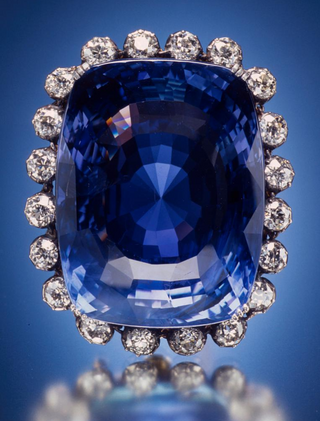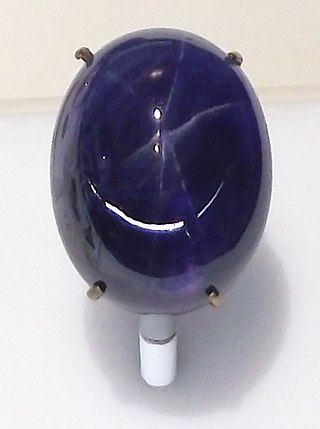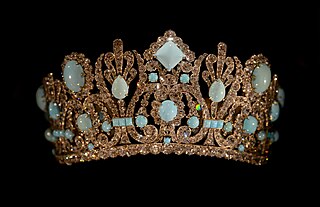
Sapphire is a precious gemstone, a variety of the mineral corundum, consisting of aluminium oxide (α-Al2O3) with trace amounts of elements such as iron, titanium, cobalt, lead, chromium, vanadium, magnesium, boron, and silicon. The name sapphire is derived via the Latin "sapphirus" from the Greek "sappheiros", which referred to lapis lazuli. It is typically blue, but natural "fancy" sapphires also occur in yellow, purple, orange, and green colors; "parti sapphires" show two or more colors. Red corundum stones also occur, but are called rubies rather than sapphires. Pink-colored corundum may be classified either as ruby or sapphire depending on locale. Commonly, natural sapphires are cut and polished into gemstones and worn in jewelry. They also may be created synthetically in laboratories for industrial or decorative purposes in large crystal boules. Because of the remarkable hardness of sapphires – 9 on the Mohs scale (the third hardest mineral, after diamond at 10 and moissanite at 9.5) – sapphires are also used in some non-ornamental applications, such as infrared optical components, high-durability windows, wristwatch crystals and movement bearings, and very thin electronic wafers, which are used as the insulating substrates of special-purpose solid-state electronics such as integrated circuits and GaN-based blue LEDs. Sapphire is the birthstone for September and the gem of the 45th anniversary. A sapphire jubilee occurs after 65 years.

The Hope Diamond is a 45.52-carat (9.104 g) diamond extracted in the 17th century from the Kollur Mine in Guntur, India. It is blue in color due to trace amounts of boron. Its exceptional size has revealed new information about the formation of diamonds.

The National Museum of Natural History is a natural history museum administered by the Smithsonian Institution, located on the National Mall in Washington, D.C., United States. It has free admission and is open 364 days a year. In 2022, with 3.9 million visitors, it was the most-visited museum in the United States.
The Heart of Eternity is a diamond measuring 27.64 carats, rated in color as "Fancy Vivid Blue" by the Gemological Institute of America. The Heart of Eternity was cut by the Steinmetz Group, who owned the diamond before selling it to the De Beers Group.

The Logan Sapphire is a 422.98-carat (84.596 g) sapphire from Sri Lanka. One of the largest blue faceted sapphires in the world, it was owned by Sir Victor Sassoon and then purchased by M. Robert Guggenheim as a gift for his wife, Rebecca Pollard Guggenheim, who donated the sapphire to the Smithsonian Institution in 1960. The sapphire's name is derived from Rebecca's new surname after she later married John A. Logan. It has been on display in the National Gem Collection of the National Museum of Natural History in Washington, D.C., since 1971. It is a mixed cushion-cut sapphire, approximately the size of a large chicken egg, and set in a silver and gold brooch surrounded by 20 round brilliant-cut diamonds.

Harry Winston was an American jeweler. He donated the Hope Diamond to the Smithsonian Institution in 1958 after owning it for a decade. He also traded the Portuguese Diamond to the Smithsonian in 1963 in exchange for 3,800 carats of small diamonds.

The Star of Bombay is a 182-carat (36.4-g) cabochon-cut star sapphire originating in Sri Lanka. The violet-blue gem was given to silent film actress Mary Pickford by her husband, Douglas Fairbanks. She bequeathed it to the Smithsonian Institution. It is the namesake of the popular alcoholic beverage Bombay Sapphire, a British-manufactured gin.

The Tavernier Blue was the precursor diamond to the Blue Diamond of the French Crown. Subsequently, most scholars and historians believe that it was re-cut and, after a disappearance and reemergence into the public forum, was renamed the Hope Diamond. It is believed to have been a Type IIb diamond.

The Chalk Emerald is a 37.82 carats (7.564 g) rectangular step-cut emerald, mined in Muzo, Colombia. It was one of many Colombian emeralds shipped to Mughal India by the Spanish in the 16th and 17th centuries. Ownership of the stone after its arrival is unrecorded until its sale by Jagaddipendra Narayan, the Maharaja of Koch Bihar, to a British gem broker in 1959. Jagaddipendra stated that the stone was formerly the centerpiece of an emerald and diamond necklace worn by his mother, Indira Devi, to various state functions.

The Maharaja of Indore Necklace is a diamond and emerald-studded necklace. As of 2008, it is on display at the National Museum of Natural History in Washington, D.C., United States. It was originally named the Spanish Inquisition Necklace by the American jeweller Harry Winston, though it had no known connection with the historical Spanish Inquisition. The name was changed in 2021 by the Smithsonian Institution to reflect its actual provenance, having been first owned by Tukoji Rao III, Maharaja of Indore in the early 20th century.

The Napoleon Diamond Necklace is a diamond necklace commissioned by Napoleon I of France c. 1811–1812 from the Parisian jeweler Marie-Étienne Nitot. It is currently on display in the Smithsonian National Museum of Natural History in Washington, D.C..

The Hooker Emerald Brooch is an emerald brooch designed by Tiffany & Co. The brooch is on display in the Janet Annenberg Hooker Hall of Geology, Gems, and Minerals at the Smithsonian Institution's National Museum of Natural History in Washington D.C., United States.

The Bismarck Sapphire Necklace is a sapphire necklace designed by Cartier, Inc. in 1935. As of 2010, the necklace is on display between the Hall Sapphire and Diamond Necklace and the Logan Sapphire in the Janet Annenberg Hooker Hall of Geology, Gems, and Minerals at the Smithsonian Institution's National Museum of Natural History in Washington D.C., United States. It is named after Countess Mona von Bismarck, who donated the piece to the Smithsonian in 1967. The sapphire itself was mined in Burma, and was purchased by the Countess in Sri Lanka in 1926 during her honeymoon with Harrison Williams.
The Dom Pedro aquamarine is the world's largest cut aquamarine gem. It was cut from a crystal originally weighing approximately 100 pounds (45 kg) and measuring more than 3 feet (0.91 m) in length. The stone was mined in Pedra Azul, in the state of Minas Gerais in Brazil around 1980, and named after the Brazilian emperors Pedro I and Pedro II. The blue-green gemstone was cut by Bernd Munsteiner into an obelisk form weighing 10,363 carats. The finished dimensions measure 14 inches (36 cm) tall by 4 inches (10 cm) wide. The jewel was donated to the Smithsonian Institution by Jane Mitchell and Jeffery Bland. It is housed in the National Museum of Natural History's Janet Annenberg Hooker Hall of Geology.
Cindy Chao is a Taiwanese jewellery designer. She founded her company, Cindy Chao The Art Jewel, in 2004. She is known for her Black Label Masterpiece Collection and Annual Butterfly.
The Allison and Roberto Mignone Halls of Gems and Minerals are a series of exhibition halls at the American Museum of Natural History on the Upper West Side in Manhattan, New York City. The halls opened on June 12, 2021, as a complete redesign of their predecessors, the Harry Frank Guggenheim Hall of Gems and Minerals and Morgan Memorial Hall of Gems. The halls feature thousands of rare gems, mineral specimens and pieces of jewelry.

The Marie Antoinette Diamond Earrings are a pair of diamond earrings on permanent display in the Smithsonian National Museum of Natural History in Washington, D.C., United States. They are so named for their assumed provenance: that they were commissioned by King Louis XVI of France for his wife, Queen Marie Antoinette. While there is limited documentation and circumstantial evidence attesting to the truth of this claim, the origin of the earrings has never been definitively proven.

The Marie Louise Diadem is a diamond and turquoise diadem on permanent display at the National Museum of Natural History in Washington D.C.. It is named for Marie Louise of Austria, the wife of Emperor Napoleon of France.














